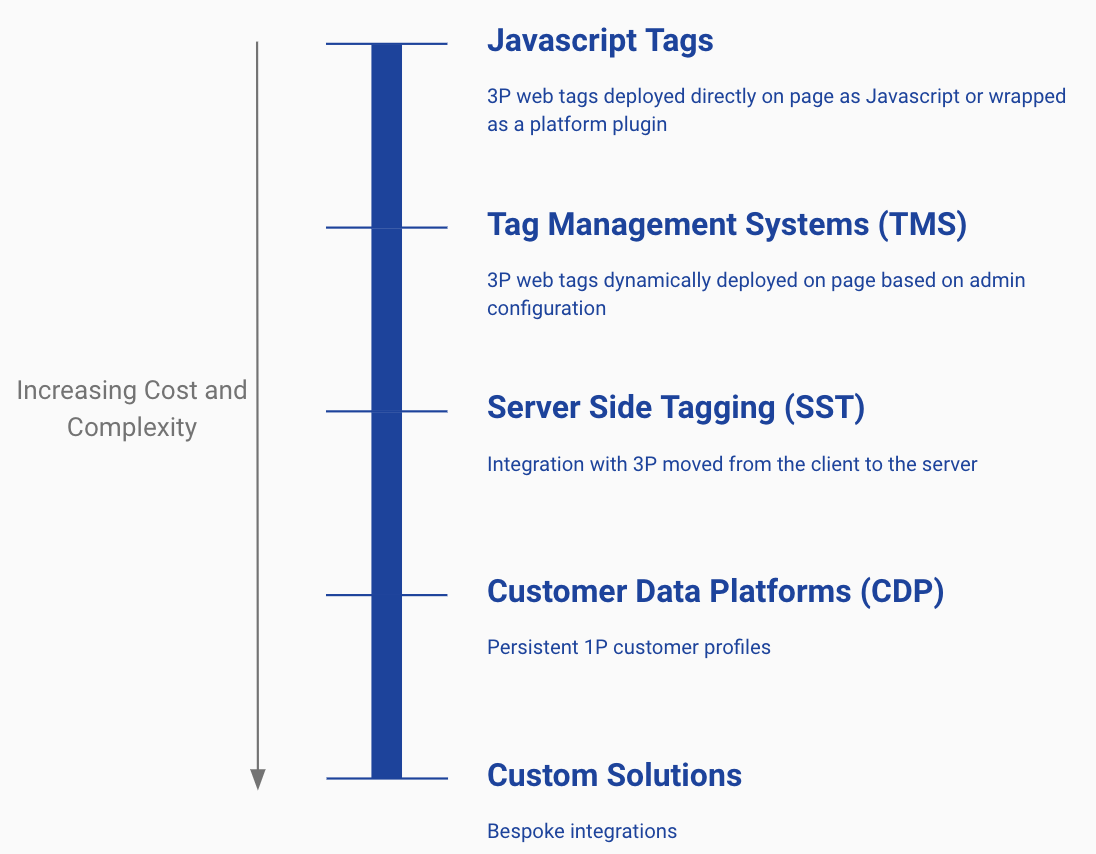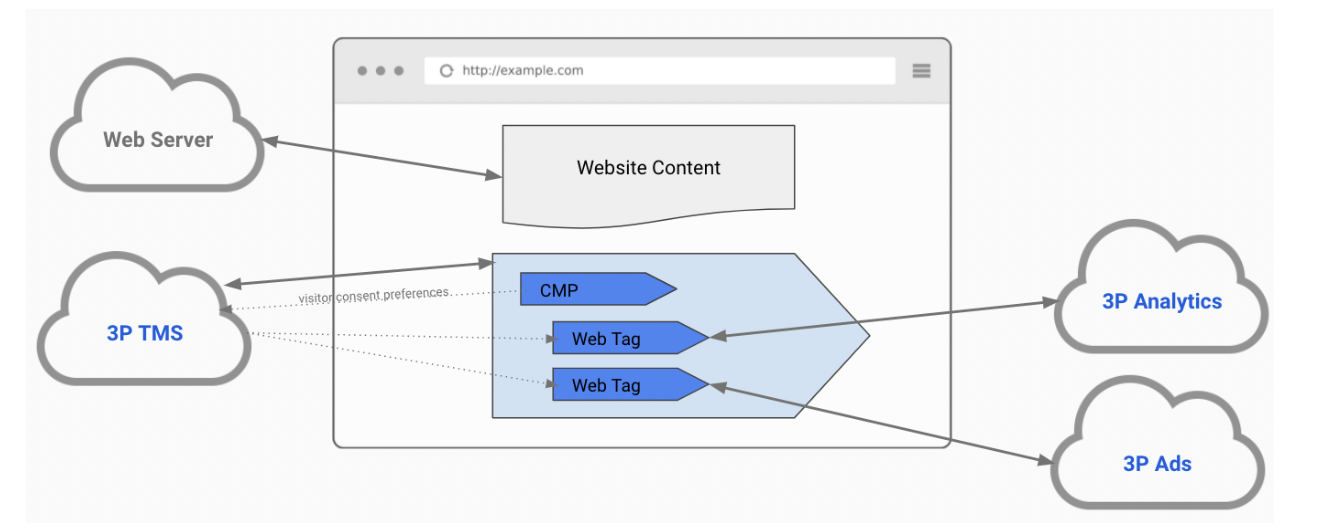What comes after third-party cookies?
While the final date may still be changing, the end of third-party cookies is coming. Website operators need a new way to identify users and to share user data with partners in a way that is not browser-dependent.
Tackling this challenge now, rather than waiting and being forced to adapt reactively, will save companies time, resources, and technical challenges down the road. On the positive and proactive side, consent is at the center of this change, which is core to Usercentrics’ values and business. We are already seeing increased interest and questions on this topic, and are learning about customers’ needs based on what we’re hearing.
Website operators have used Javascript tags for years, leading to the development of tag management systems (TMS) for more sophisticated management. Companies relied on third-party data for a lot of insights and revenue. However, that is changing as well, shifting to first party-data.
The evolution is significant for companies and customers. It puts more control over privacy in website visitors’ hands, but also requires companies to rethink their data strategies in order to continue to optimize data acquisition and revenue generation.
Server-side tagging (SST) is a part of this next evolutionary leap forward. (Learn more with An introduction to server-side tagging.) SST has led to and works with additional data management technologies as well, like customer data platforms (CDP) and data warehouses, depending on companies’ size, available resources, and who tends to drive its data strategies.
Server-to-server sharing (as with SST) will solve a number of today’s issues. Some of these issues include degraded website performance due to tag configuration, limited control over and ability to audit script behaviors, less robust security due to greater access to systems and data by third parties, and a choppy overview of customers due to disparate data sources, like ad blockers and other technologies that limit or expire cookies.
SST will also help address challenges that will result from the industry’s continued evolution, like the fallout from deprecation of third-party cookies and move away from client-side tagging and tracking.
Server-side tagging can integrate with any channel — web, apps, smart devices, etc. — and will result in more consistent data, better automation, reduced costs, better consent management across platforms, and improved industry standards benefitting both companies and users.
Learn more about how server-side tracking and consent management go hand in hand: How Server-side tracking and consent management creates harmony between privacy and data.
Companies now have more and more data to manage, and are working with increasingly sophisticated platforms for doing so. But how do they enable disparate systems — some of them controlled by third parties — to work together so data can be accessed and activated to get full value from it?
Companies rely on data for revenue, and data sharing is critical for understanding user behavior to target, serve and measure ads.
For GDPR compliance, among other regulations, granular and informed user consent must also be obtained before collecting their data, as well as before sharing it with third parties via third-party platforms. Learn more: Bring performance and privacy together with Server-Side Tagging.
The move to SST, also sometimes called server-side tracking, helps solve these current and nascent issues and improve on current processes. When integrations are moved server-side, it enables:
- a comprehensive view of customers across various touch points
- improvements in website and data security
- improvements in the performance of companies’ websites
- provides a single source of information for legal audits
- better adaptation to changes in privacy regulations and technologies
- full control of sharing of consented data with third-party partners
Client-side tagging vs. Server-side tagging
Both client-side and server-side tagging — and thus client- or server-side tracking — enable collection and delivery of data, and each has benefits. Client-side tagging uses tags and the user’s browser (the client) to directly send data to a server or multiple servers. Tag management uses this functionality to share data from your website with marketing technology partners. There is no centralized control of the data with this model.
With server-side tagging, the tag or pixel sends data to the web server (or another server), and then the web server passes the data to a destination server or servers. Marketing technology partners can be the recipients that use the data, analytics providers, etc. There is one data stream, which both enables and controls relevant services’ access to the data. Because data is collected and relayed to third parties by a central system, there is overarching control over the conditions for access to and use of that data. For example, users’ granular consent, which can allow certain cookies or other web technologies, but decline others.
Our partner Tealium has an excellent article to learn more: Choosing Between Client-side and Server-side Data Management.
Server-side tagging benefits
Businesses
Data processing and distribution is moved from the client to the server. Website administrators get increased control and the ability to more fully manage and audit data shared with third parties. Website performance is increased, for example because there is no need to load “heavy” third-party technologies, no longer a container tag degrading it, and only one tag needs to be implemented.
Server-side tagging also increases website security, with built-in features that serve to limit access to the website and data gathered from it. Even though server-side tagging does come with increased costs, like for a dedicated web server, the investment is foundational for establishing corporate data strategy. Large industry shifts over the next few years will affect all businesses, so small businesses will need solutions as well, and will reap the benefits of these technologies.
Server-side tagging leverages first-party server capabilities to bring tracking closer to website content. For example, it prevents ad blockers from blocking content, and prevents Safari’s ITP shortening of HTTP cookie lifetime or the deletion of those cookies entirely.
Marketing teams also benefit from server-side tracking, with improved visibility into the purchasing cycle and increased conversion rates and ROI on advertising.
Website visitors
Privacy and security for website visitors’ data is improved, as once their consent choices are received, they can be better communicated across systems to ensure no data collection or sharing without their consent. Access to and control over data collected is also more limited. As noted, companies maintain control over the data, rather than third-party vendors having broad direct access to data. Targeting, e.g. for ads, can also be improved, enabling the personalization that users express a desire for, without sacrificing privacy to achieve it.
With SST, website users can lose some visibility in the browser into what personal data of theirs is collected and shared, and how, because activities no longer take place in individuals’ browsers, but rather on the server. However, Usercentrics is working with tagging platforms to restore visibility by integrating the CMP to extract information about data and purposes. This information will then be shared with website visitors in the consent banner.
Third-party vendors
Third-party vendors, like those providing customer data platforms or data warehouse solutions, gain confidence with SST that granular consent has been obtained from users for their data and any activities undertaken with it. Risk of data privacy violations is decreased, as is the risk of unauthorized data access, since that is more controlled.
Companies can also develop better communication and shared insights with vendors as the business centralizes their control over website behavior and determines data flow.
Conclusion
Figuring out how to integrate new technologies is always a challenge. Companies have had the convenience of being able to drag and drop tags, and with server-side tagging they will need to give more thought to their data and how it is shared.
But investment in long-term data strategy sets companies up for plenty of new opportunities and can earn substantial dividends in the future in business intelligence, data-driven decision-making, and more.
SST is a positive change for both businesses and visitors, and companies do need to be aware that eventually third-party cookies will go away. They risk losing a lot of data and associated insights if they don’t plan for change.
Companies need to fully understand their data and consent requirements. They also need a long-term marketing strategy and clear requirements for vendor integrations. These are all important initial steps in preparing for coming changes. At Usercentrics, we can help guide you and help you leverage the expertise of our implementation partners on how server-side tagging can work for your business.
Learn more about server-side tagging and the future of first-party data today. Or get in touch with us any time if you have additional questions.

